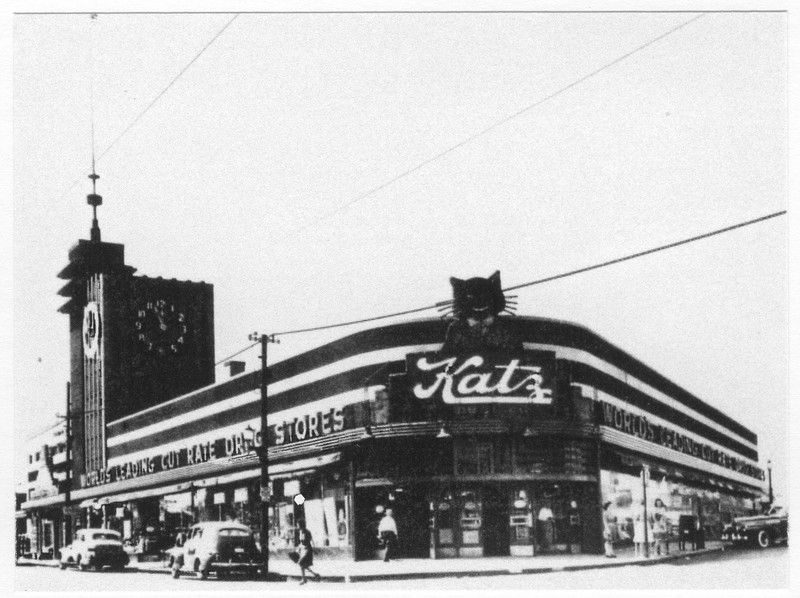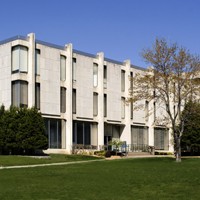Michael H. and Rose Katz House
Introduction
Text-to-speech Audio
The Michael H. and Rose Katz Residence, built in 1928, was the home of drug store mogul Michael H. Katz and his wife, Rose. The imposing Tudor-style home sits along Kansas City's illustrious Ward Parkway, where numerous prominent local citizens purchased property and developed stately homes during the 1920s. Together with his brother Isaac Katz, Michael operated drugstores in Kansas City at the start of World War I, and the chain grew rapidly in the 1920s. At its peak, there were over sixty Katz stores from Oklahoma to the upper Midwest and consumers appreciated the opportunity to shop for housewares and other items while they awaited a prescription. Katz became a household name for Midwestern families, and many Kansas City residents recall seeing the ubiquitous Katz logo on products like their house brand beer and their store marquees. Michael and Isaac Katz supported numerous charitable causes, including Menorah Hospital and other Jewish institutions. UMKC's Katz Hall, now home to the departments of Architecture and Urban Planning, was completed in 1965 and was home to the School of Pharmacy prior to its move to the Health Sciences Building at the university's Hospital Hill campus.
Images
Michael H. and Rose Katz House

Katz Drugstore

UMKC's Katz Hall was originally home to the School of Pharmacy

Backstory and Context
Text-to-speech Audio
Brothers Michael and Isaac Katz, sons of Polish immigrants, spent their early childhood in Minnesota. Isaac left Minnesota to work on odd jobs along the railroad, later moving to Kansas City in the early 1900s, where he opened a fruit stand. When Michael turned 16, he joined Isaac in business, opening a cigar shop and confectionary in the lobby of the Adams Hotel across from the old Union Station.
Michael Katz enjoyed a talent for merchandising and business. For instance, the government levied a sales tax on cigarettes at the start of World War I. Most tobacconists in the area increased their prices, sometimes raising prices as much as five cents a pack to increase their profits. In contrast, Michael continued to sell packs at the regular ten-cent price while advertising that Katz would "pay the tax." In three days, the Katz brothers sold more cigarettes than they sold the entire month. The brothers used their success to open a second store but ran into trouble when a syndicate gang seeking to fix cigarette prices contacted them. Thus, Michael and Isaac decided to diversify and expand their product line to offset their tobacco sales.
When the city passed an ordinance that allowed for drug stores to remain open past 6 p.m., the brothers hired druggists and transitioned their stores into drug stores, which included selling everything from patented medicine and housewares to "Katz Beer" and pet monkeys. As they had always done, they advertised, successfully marketed, and kept prices low (they relied on volume sales). By the 1930s, the brothers had expanded beyond the Kansas City area with a store in St. Paul, Minnesota, where the two brothers had been born. By 1933, with the nation in the grips of the Great Depression, the brothers had expanded to eight stores generating several million dollars in sales.
The continued success of Michael Katz's drugstores allowed Katz to build a home among Kansas City's elite on Ward Parkway in the late 1920s. Plans for the renowned parkway, sometimes called the "Gold Coast," arose during the first decade of the twentieth century. The neighborhood featured spectacular landscaping and lavish homes built by some of the city's most acclaimed architects. The luxurious Michael H. and Rose Katz residence, designed in the Tudor Style, is exemplary of the homes built for wealthy business people in the years before the Great Depression, and the home reflects the couple's wealth and prominence.
On March 18, 1930, roughly the same time that an article appeared in The Kansas City Star announcing the completion of Michael Katz's new Ward Parkway home, Michael was kidnapped and held for thirty-four hours until his brother Isaac paid a $100,000 ransom. No arrest was made regarding the crime, although many suspected it had ties to syndicate gangs.
The Katz store remained in business until 1970. At its peak, the Katz drugstore chain grew to sixty-five stores in five states. While economically successful, the business found itself in the middle of the growing civil rights protests after World War II, namely because the stores did not serve Black customers at the soda fountain counters. Sit-ins and protests, sometimes lengthy, took place at Katz stores during the 1940s and 1950s in Iowa and Oklahoma. In fact, after three days of student sit-ins in Oklahoma City, the Katz Drug Store managers agreed to serve the Black students, and the counter was integrated.
By 1970, the Katz drugstore had been sold to a competing national chain, but the home is a reminder of how two Polish immigrants used clever marketing to sell cigarettes and drug store goods, which allowed them to amass a fortune. The mansion sits among many elaborate homes, most in the prosperous years before the Great Depression. Echoes of the Katz store can be found throughout Kansas City, including the Art Deco clock tower at Main and Westport that was preserved as part of the terms of that former store's conversion to the Katz on Main luxury apartment complex. The Katz legacy can be found in several other downtown buildings, as well as UMKC's Katz Hall, which was funded by a gift of $600,000 by Michael Katz. Originally home to the pharmacy department, the building is now home to the Department of Architecture and Urban Planning and Design.
Cite This Entry
Powers, Mathew and Clio Admin. "Michael H. and Rose Katz House." Clio: Your Guide to History. October 9, 2024. Accessed March 26, 2025. https://theclio.com/entry/182156
Sources
Millstein, Cydney E. and Mary Ann Warfield. "Registration Form: Katz, Michael H. and Rose, House." National Register of Historic Places. mostateparks.com. 2003. https://mostateparks.com/sites/mostateparks/files/Katz%2C%20Michael%20H.%20and%20Rose%2C%20Residence.pdf.
"The Story of Katz Drug Stores." KC Yesterday. Accessed May 29, 2024. https://kcyesterday.com/articles/katz-drug-stores.
Worley, William S. J.C. Nichols and the Shaping of Kansas City: Innovation in Planned Residential Communities. Columbia: University of Missouri Press, 1990.
Celisa, Calacal. Only a shell remains of Midtown's Katz Drug Store. Here's where the luxury apartment project stands, KCUR. September 10th, 2022. Accessed May 30th, 2024. https://www.kcur.org/housing-development-section/2022-09-10/only-a-shell-remains-of-midtowns-katz-drug-store-heres-where-the-luxury-apartment-project-stands.
By Mwkruse - Own work, CC BY-SA 3.0, https://commons.wikimedia.org/w/index.php?curid=42382082
https://kcyesterday.com/articles/katz-drug-stores

